A number is an arithmetic value used for representing quantity and used in making calculations.
We use the digits from 0 to 9 to form all other numbers.
| 0 | 1 | 2 | 3 | 4 | 5 | 6 | 7 | 8 | 9 |
With the help of these digits, we can create infinite numbers e.g. 10,11,50,19,10001,etc.
Natural/Counting Numbers
These are numbers known as counting numbers that contain the positive integers from 1 to infinity.
The set of natural numbers denoted as "N" and it includes, N = {1,2,3,4,5,6,7,8,...}
Whole Numbers
These are known as non-negative integers and it does not include any fraction or decimal part.
It is denoted as "W" and the set of whole numbers includes, W = {0,1,2,3,4,5,6,7,8,9,10,...}
NOTE: Whole numbers include the integer, 0 but natural numbers do not include 0 since it starts from 1.
We can therefore say that set of natural numbers is a subset of set of whole numbers (can be found in the set of whole numbers).
Integers
These are the set of all whole numbers but it includes a negative set of natural numbers also. Hence whole numbers and natural numbers are subsets of set of integers.
"Z" represents integers and the set of integers include, Z = {...,-5,-4,-3,-2,-1,0,1,2,3,4,5,6,7,8,...}
Real numbers
All the positive and negative integers, fractional and decimal numbers without imaginary numbers. Hence the set of natural numbers, whole numbers, integers, fractional and decimal numbers are all subsets of the set of real numbers.
Rational Numbers
Any number that can be written as a ratio of one number over another is known as rational numbers. This means that any number that can be written in the form a/b, where b is a non-zero number is a rational number.
Any fraction with non-zero denominators is a rational number. E.g. 1/4,2/3,6/9 and so on.
The number "0" is also a rational number, as we can represent it in many forms such as 0/1, 0/2, 0/3,0/4,0/5, etc.
The symbol "Q" represents the rational number.
Irrational Numbers
These are numbers that cannot be expressed as the ratio of one over another, thus no ratio can be written for that number.
In other words, we can say that irrational numbers cannot be represented as the ratio of two integers.
Examples include, pi(π=3.14159265…), √2, √3, √5, etc.
It is represented by the symbol "P".
Complex Numbers
These are numbers that can be written in the form of a+bi where "a" and "b" are the real number and the "i" is an imaginary number. E.g. 1+2i, where 1 is the real number and 2i the imaginary number
It is represented by the symbol "C".
Imaginary Numbers
These are complex numbers that can be written in the form of the product of a real number and the imaginary unit "i". Eg. 2i,3i,4i, etc.
Even Numbers
These are numbers exactly divisible by 2. These can be positive or negative integers.
Examples include 2, 4, 6, 8, 10, 12, 14, 16, 18, 20, 22, 24, 26, 28, 30, 32, 34, 36, 38, 40, 42, 44, 46, 48, 50, 52, 54, 56, 58, 60, 62, 64, 66, 68, 70, 72, 74, 76, 78, 80, 82, 84, 86, 88, 90, 92, 94, 96, 98, 100,...
All the multiples of 2 (positive and negative) are even numbers.
Odd Numbers
These are numbers which are not exactly divisible by 2. These can be both positive and negative integers.
All integers which are not in the set of multiples of 2 are odd numbers.
Examples include 1, 3, 5, 7, 9, 11, 13, 15, 17, 19, 21, 23, 25, 27, 29, 31, 33, 35, 37, 39, 41, 43, 45, 47, 49, 51, 53, 55, 57, 59, 61, 63, 65, 67, 69, 71, 73, 75, 77, 79, 81, 83, 85, 87, 89, 91, 93, 95, 97, 99,...
Prime Numbers
These are numbers that have only two factors,thus 1 and the number itself. These numbers can only be exactly divisible by 1 and the number itself.
Examples include 2, 3, 5, 7, 11, 13, 17, 19, 23, 29, 31, 37, 41, 43, 47, 53, 59, 61, 67, 71, 73, 79, 83, 89, 97,...
Composite Numbers
These are numbers that have more than two factors.
Examples include 4, 6, 8, 9, 10, 12, 14, 15, 16, 18, 20, 21, 22, 24, 25, 26, 27, 28, 30, 32, 33, 34, 35, 36, 38, 39, 40, 42, 44, 45, 46, 48, 49, 50, 51, 52, 54, 55, 56, 57, 58, 60, 62, 63, 64, 65, 66, 68, 69, 70, 72, 74, 75, 76, 77, 78, 80, 81, 82, 84, 85, 86, 87, 88, 90, 91, 92, 93, 94, 95, 96, 98, 99, 100,...
NOTE: 1 is neither a prime nor composite number
APPLICATION OF KNOWLEDGE
Question 1
Which of the following is the largest set?
A. {Whole numbers} B. {Composite} C. {Natural numbers} D. {Integers}
[B.E.C.E 2022 Section A Question 21]
Question 2
If P = {x:x is an even number greater than two and less or equal to twelve}, list the members of P
A. {2, 4, 2, 8, 10, 12} B. {3,4,6,8,10,12}
C. {2, 4, 6, 8, 10} D. {4, 6, 8, 10, 12}
[B.E.C.E 2018 Section A Question 2]
Question 3
E and F are subsets of the universal set U such that
U = {natural numbers less than 15}
E = {even numbers between 1 and 15}
F = {multiples of 4 between 9 and 15}
List the elements of U,E and F
[B.E.C.E 2008 Section B Question 1]
Question 4
If the set P = {1,2,3,4,5} which of the following statements best describes P?
A. Set of whole numbers up to 6
B. Set of counting numbers less than 6
C. Set of counting numbers greater than 6
D. Set of integers less than 6
[B.E.C.E 2005 Section A Question 5]
Question 5
U = {1,2,3,4,...,18};
A = {Prime numbers} and
B = {Odd numbers greater than 3}.
If A and B are subsets of the universal set, U, list the members of A and B
[B.E.C.E 2003 Section B Question 1]
NOTE: The list of the subsets should be elements in the universal set, U. Hence can't be more than 18
Addition in math is a process of combining two or more numbers. Addends are the numbers being added, and the result or the final answer we get after the process is called the sum.
The addition symbol used to indicate addition of numbers is "+", called the plus symbol
We can the numbers vertically. Here, we arrange the numbers vertically using their respective place values, like ones, tens, hundreds, thousands, etc. We start adding from the right side (or digit at ones or unit place).
To add numbers, you can follow the steps below:
Step 1
Write the numbers one below the other as per the places of the digits. It is better to arrange by the number of digits. The number with the highest digits comes first followed by the next and so on.
Step 2
Start adding from the digits in ones place. Write the sum under the ones digit.
If the resut is 10 or more (two digits), write the first digit (the ones) and carry-over the second digit (the tens)
Step 3
Add the tens digits, the hundreds, the thousands and so on.
If the resut is 10 or more (two digits), write the first digit (the ones) and carry-over the second digit (the tens)
Place value chart
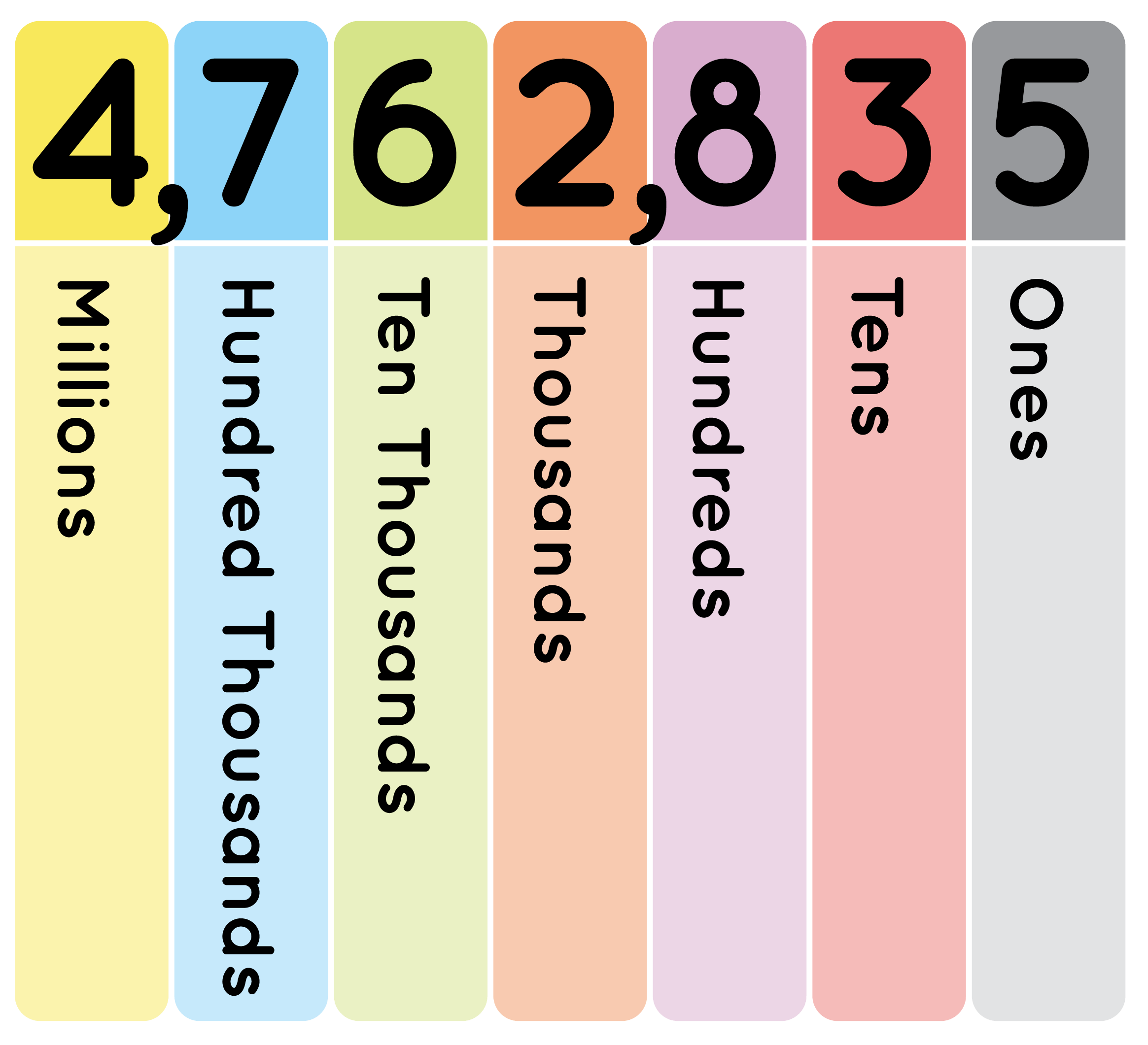
ILLUSTRATIONS
Example 1
Add 34 and 52
Step 1
Write the numbers one below the other as per the places of the digits
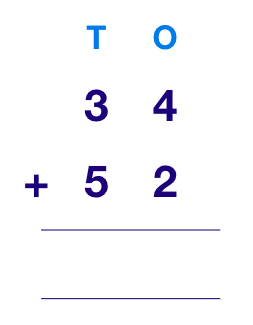
Step 2
Start adding from the digits in ones place. Write the sum under the ones digit.
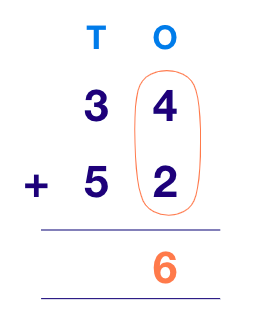
Step 3
Add the tens digits, the hundreds, the thousands and so on.
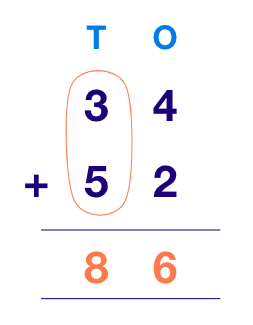
34 + 52 = 86
Example 2
Add 29 and 46
Step 1
Write the numbers one below the other as per the places of the digits
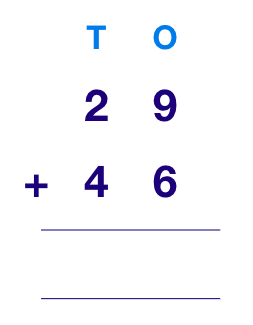
Step 2
Start adding from the digits in ones place. Write the sum under the ones digit.
If the resut is 10 or more (two digits), write the first digit (the ones) and carry-over the second digit (the tens)
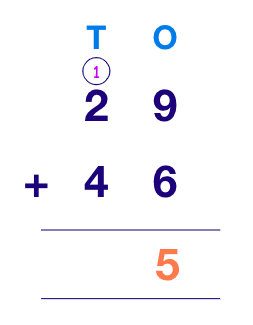
9 + 6 = 15, the ones/first digit (5) is written and the tens/second digit is carried-over
Step 3
Add the tens digits, the hundreds, the thousands and so on and their corresponding carry-overs.
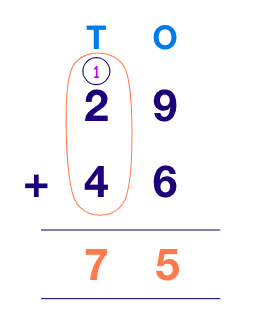
29 + 46 = 75
Example 3
Add 3475 and 2865
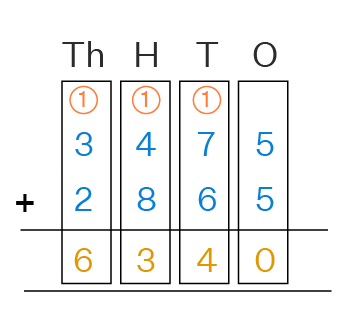
Explanation
Step 1
5 + 5 = 10
The ones (0) part is written and the tens digit, carry-over (1) is taken to the next digit
Step 2
1 + 7 + 6 = 14
The ones (4) part is written and the tens digit, carry-over (1) is taken to the next digit
Step 3
1 + 4 + 8 = 13
The ones (3) part is written and the tens digit, carry-over (1) is taken to the next digit
Step 4
1 + 3 + 2 = 6
3475 + 2865 = 6340
The operation or process of finding the difference between two numbers or quantities is known as subtraction. To subtract a number from another number is also referred to as 'taking away one number from another'. The symbol for subtraction is "-".
Terms in subtraction
Minuend: A minuend is the number from which the other number is subtracted.
Subtrahend: A subtrahend is the number which is to be subtracted from the minuend.
Difference: A difference is the final result after subtracting the subtrahend from the minuend.
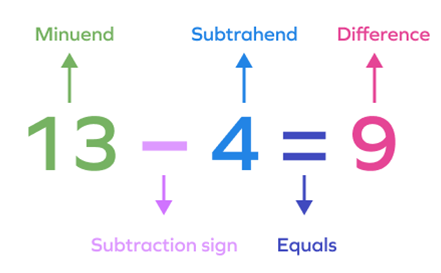
To subtract one number from the other, follow the steps below:
Step 1
Write the numbers one below the other as per the places of the digits.
Step 2
Start subtracting from the digits in ones place. Write the difference under the ones digit.
If the subtrahend is larger than the minuend, borrow 1 from the next digit which becomes 10 when adding to the preceeding digit and so on.
Step 3
Subtract the tens digits, the hundreds, the thousands and so on.
If the subtrahend is larger than the minuend, borrow 1 from the next digit which becomes 10 when adding to the preceeding digit and so on.
ILLUSTRATIONS
Example 1
Subtract 3248 from 6589
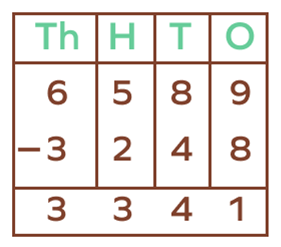
Example 2
Subtract 19 from 31
Step 1
Write the numbers one below the other as per the places of the digits.
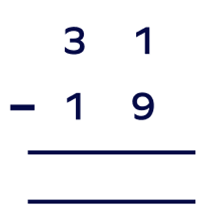
Step 2
Start subtracting from the digits in ones place. Write the difference under the ones digit.
If the subtrahend is larger than the minuend, borrow 1 from the next digit which becomes 10 when adding to the preceeding digit and so on.
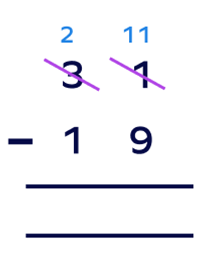
9 is larger than 1 hence 1 is borrowed from 3 which becomes 10 and its added to the 1 at the ones to give 11.
The 3 at the tens becomes 2 since 1 has been borrowed.
9 is then subtracted from the 11 giving 2
1 is then subtracted from the 2 to give 1
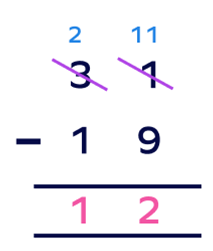
31 - 19 = 12
Example 3
Subtract 25632 from 48756
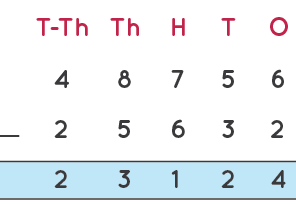
Example 4
Subtract 3678 from 8162
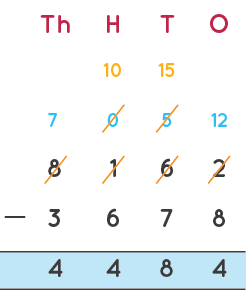
Explanation
Step 1
8 is larger than 2, hence 1 is borrowed from 6 and its added to 2 which becomes (10+2 = 12) and 8 can now be subtracted from the 12 which gives 4
The 6 that the one is borrowed from now becomes 5
Step 2
7 is larger than 5, hence 1 is to be borrowed from the next digit (1) which becomes (10+5 = 15) and 7 can now be subtracted from the 15 which gives 8
Step 3
When 1 is borrowed from the 1, it becomes 0. 6 is greater than 0, hence 1 is borrowed from 8 which becomes (10+0 = 10) and 6 can now be subtracted from the 10 which gives 4
Step 4
The 8 becomes 7 when 1 is borrowed. The 3 is now subtracted from the 7 which gives 4
8162 - 3678 = 4484
Multiply means the repeated addition of groups of equal sizes. The symbol for multiplication is "x"
When we multiply two numbers, the answer is called product. The number of objects in each group is called multiplicand, and the number of such equal groups is called the multiplier

To list the multiplications of a number, you have to repeatedly add the number to get each terms
EXAMPLES
Multiples of 2
| 2 | x | 1 | = | 0+2 | = | 2 |
| 2 | x | 2 | = | 2+2 | = | 4 |
| 2 | x | 3 | = | 4+2 | = | 6 |
| 2 | x | 4 | = | 6+2 | = | 8 |
| 2 | x | 5 | = | 8+2 | = | 10 |
| 2 | x | 6 | = | 10+2 | = | 12 |
| 2 | x | 7 | = | 12+2 | = | 14 |
| 2 | x | 8 | = | 14+2 | = | 16 |
| 2 | x | 9 | = | 16+2 | = | 18 |
| 2 | x | 10 | = | 18+2 | = | 20 |
| 2 | x | 11 | = | 20+2 | = | 22 |
| 2 | x | 12 | = | 22+2 | = | 24 |
| 2 | x | 13 | = | 24+2 | = | 26 |
| 2 | x | 14 | = | 26+2 | = | 28 |
| 2 | x | 15 | = | 28+2 | = | 30 |
Thus the multiples of 2 are 2,2+2 = 4,4+2 = 6,6+2 = 10, 10+2 = 12, 12+2 = 14, 14+2 = 16, 16+2 = 18, 18+2 = 20, 20+2 = 22, 22+2 = 24, 24+2 = 26, 26+2 = 28, 28+2 = 30,...
Multiples of 3
3, 3+3 = 6, 6+3 = 9, 9+3 = 12, 12+3 = 15, 15+3 = 18, 18+3 = 21, 21+3 = 24, 24+3 = 27, 27+3 = 30, 30+3 = 33, 33+3 = 36,...
You can use this step of obtaining the multiples of a number to write down the multiplication tables that you have difficulty in memorizing on the question paper before solving the examination questions so that you can quickly make reference to them in case you are not allowed to carry calculator to the examination hall.
While solving multiplication problems, one-digit numbers can be multiplied in a simple way by using the multiplication tables, but for larger numbers, we split the numbers into columns using their respective place values, like ones, tens, hundreds, thousands, and so on.
Type of multiplication problems
1. Multiplication without regrouping
2. Multiplication with regrouping
Multiplication without regrouping
Multiplication of two numbers without regrouping involves smaller numbers where there is no need to take a carry-over to the next higher place value. It is the basic level that could help a learner understand the basics of multiplication before moving on to the higher level of problems including regrouping.
Steps
Multiply each of the digits starting from the ones by the multiplier
NOTE: When the multiplier has more than one digits (ones, tens, hundreds, ...), after the multiplication of each digit, you start with zeros at the ones, tens,hundreds, etc before multiplying the subsequent digits.
Once you are done with the multiplication of each of the digits of the multiplier, you can sum their products to obtain the final answer.
Example 1
Multiply 42312 by 2
| TTh | Th | H | T | O |
| 4 | 2 | 3 | 1 | 2 |
| x | 2 | |||
| 8 | 4 | 6 | 2 | 4 |
Explanation
Step 1
Multiply the ones part(2) by 2 = 2 x 2 = 4 and write it below
Step 2
Multiply the tens part(1) by 2 = 1 x 2 = 2 and write it below
Step 3
Multiply the hundreds part (3) by 2 = 3 x 2 = 6 and write it below
Step 4
Multiply the thousands part(2) by 2 = 2 x 2 = 4 and write it below
Step 5
Multiply the ten thousands part(4) by 2 = 4 x 2 = 8 and write it below
Multiplication with regrouping
In this type of multiplication, we need to take a carry-over to the next higher place value. Thus the product gives more than one digit, hence the ones part (first digit) is written and the tens part (second digit) is carried over.
Example 1
Find the product of 2468 and 8
| Th | H | T | O | |
| 3 | 5 | 6 | ||
| 2 | 4 | 6 | 8 | |
| x | 8 | |||
| 1 | 9 | 7 | 4 | 4 |
Explanation
Step 1
8 x 8 = 64, we write down the ones part (4) and carry-over the tens part(6)
Step 2
6 x 8 = 48. There is already carry-over of 6, hence we add the 6 to the 48, 48+6 = 54. we write down the ones part (4) and carry-over the tens part(5)
Step 3
4 x 8 = 32. There is already carry-over of 5, hence we add the 5 to the 32, 32+5 = 37. we write down the ones part (7) and carry-over the tens part(3)
Step 4
2 x 8 = 16. There is already carry-over of 3, hence we add the 3 to the 16, 16+3 = 19. Since that's the last part we write down the result (19).
Example 2
Find the product of 1021 and 32
| Th | H | T | O | ||
| 1 | 0 | 2 | 1 | ||
| x | 3 | 2 | |||
| 2 | 0 | 4 | 2 | ||
| + | 3 | 0 | 6 | 3 | 0 |
| 3 | 2 | 6 | 7 | 2 | |
Explanation
Multiplication by the ones part (2) of the 32 multiplier
Step 1
1 x 2 = 2
Step 2
2 x 2 = 4
Step 3
0 x 2 = 0
Step 4
1 x 2 = 2
Multiplication by the tens part (3) of the 32 multiplier
Step 5
Since that's the second digit, start with zero (0)
Step 6
1 x 3 = 3
Step 7
2 x 3 = 6
Step 8
0 x 3 = 0
Step 9
1 x 3 = 3
Step 10
Now that we have multiplied all the digits of the multiplier with the multiplicand, we will add the digits obtained in a vertical manner
2042 + 30630 = 32672
Example 3
Find the product of 1025 and 34
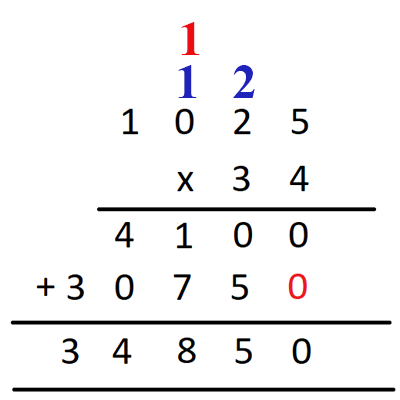
A factor is a number that divides another number, leaving no remainder. In other words, if multiplying two whole numbers gives us a product, then the numbers we are multiplying are factors of the product because they are divisible by the product.
For example 2 x 3 = 6, hence 2 and 3 are factors of 6
Thus factors of a number are the list of numbers which can exactly divide that number without a remainder. Every number has a factor of 1 and itself since one divides all numbers without a remainder and the number can divide itself as well without a remainder.
Factors of 2
{1,2}
Factors of 3
{1,3}
Factors of 4
{1,2,4}
Factors of 5
{1,5}
Factors of 6
{1,2,3,6}
Factors of 7
{1,7}
Factors of 8
{1,2,4,8}
Factors of 9
{1,3,9}
Factors of 10
{1,2,5,10}
Verifying if all factors has been listed
1. List the factors in ascending order (from the lowest to the highest)
2. Multiply the first by the last to see if the result gives you the number whose factor you are listing
3. Multiply the second by the last but two to see if the result gives you the number whose factor you are listing
4. You continue in that order until all the numbers paired with their product giving the number whose factor you are listing
NOTE: If the square of a factor gives the number whose factor you are listing, the number is paired by itself
Illustration
List of factors of 30 are {1,2,3,5,6,10,15,30}
You can verify if you are not missing a factor as follows
| 1 x 30 = 30 |
| 2 x 15 = 30 |
| 3 x 10 = 30 |
| 5 x 6 = 30 |
If there is an element left out, then it's pair is missing. Unless the square of that number gives the number we are looking for its factor
List of factors of 36 are {1,2,3,4,6,9,12,18,36}
You can verify if you are not missing a factor as follows
| 1 x 36 = 36 |
| 2 x 18 = 36 |
| 3 x 12 = 36 |
| 4 x 9 = 36 |
| 6 x 6 = 36 |
As you can see, during the pairing, 6 will be left alone but it's square gives the number whose factor is to be listed, hence the list is complete
If one of the numbers, doesn't have a pair and it's square doesn't give the number whose factor you are looking for, then you are missing a factor which you have to figure out.
Division is a mathematical operation which involves the sharing of an amount into equal-sized groups. For example, "8 divided by 2" means "8 shared into 2 equal groups", which would be 4.
In mathematics, this is written with the division symbol (÷), called an obelus.
Division can also be presented as a fraction which is represented as a forwards slash (/)
Thus 8 divided by 2 can be represented as 8÷2 or 8/2
The first number (the amount being divided) is called the dividend and the second number (whatever the dividend is being divided by), is called the divisor and the answer is called the quotient.
Thus in 8/2, the 8 is the dividend and the 2 is the divisor and the answer which is 4 is the quotient
Remainders
Sometimes a number cannot be shared into equal groups with an integer (whole number) as an answer, so we are left with a remainder.
For instance when dividing 11 by 2, there will be a remainder of 1 since we can split it into 5 equal groups and there will be 1 left over
Thus 11/2 = 5 remainder 1
Long Division
Long division is the mathematical method for dividing large numbers into smaller groups or parts. It helps to break down a problem into simple and easy steps.
The long divisions have dividends, divisors, quotients, and remainders.
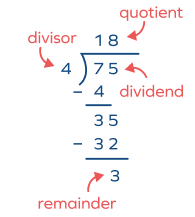
Steps for dividing numbers using long division
There are five steps to solve every long division problem with ease.
1. Divide
2. Multiply
3. Subtract
4. Bring down
5. Repeat or Remainder
Explanation to the 75/4
1. Divide
4 can go into 7, 1 time, hence the 1 is written at the quotient side.
2. Multiply
The 1, the quotient is then multiplied by the 4, the divisor and the result (4) is written down.
3. Subtract
The 4 is subtracted from 7 and the result (3) is written down together with the other remaining dividend (5) to become 35.
The steps are repeated for the new dividend (35)
Repeating step for dividend 35
1. Divide
4 can go into 35, 8 times (4 x 8 = 32), hence the 8 is written at the quotient side.
2. Multiply
The 8, the quotient is then multiplied by the 4, the divisor and the result (32) is written down.
3. Subtract
The 32 is subtracted from the 35 and the result is written down
There will be a remainder of 3
Hence 75/4 = 18 remainder 8
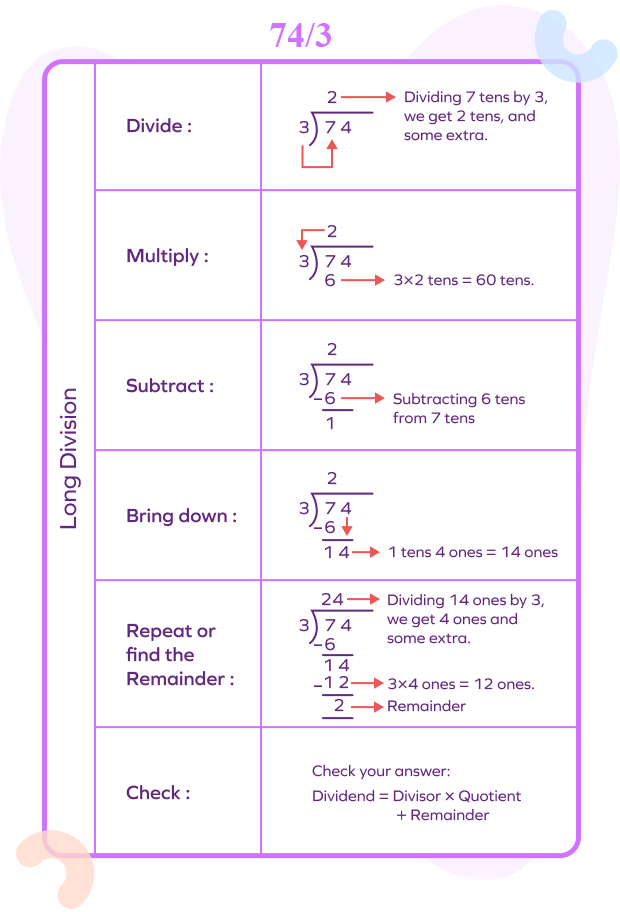
Simplifying the remainder into decimals
If the dividend is lesser than the divisor, you can add a decimal point to the quotient and add 0 to the dividend to continue with the simplification.
If the dividend is greater than the divisor, after adding the first decimal point, another other 0 you add doesn't add any point to the quotient.
If the dividend is lesser than the divisor, after the decimal point (0.), any time you add a zero, you also add zero after the decimal until the dividend is divisible by the divisor
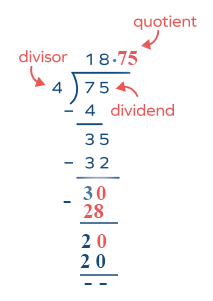
Explanation from the remainder 3
Dicimal point added to quotient
A decimal point is added to the quotient and 0 is added to the remainder 3 which becomes 30
Divide 30 by 4
4 goes into 30, 7 times (4 x 7 = 28), the 7 is written at the quotient after the decimal point
Multiply 7 by 4
The 7 at the quotient is multiplied by the divisor 4 and the result (28) is written down.
Subtract
The 28 is then subtracted from the 30 and the result (2) is written down
Add 0 to the 2
Since 4 can't go into 2, 0 is added to 2 to become 20
Divide 20 by 4
20 is divided by 4 and the result (5) is written at the quotient
Multiply 5 by 4
The 5 at the quotient is multiplied by the 4 and the result (20) is written down
Subtract 20 from 20
20 is subtracted from 20 which gives 0 (no remainder), hence the long division is completed
Examples
Divide 3 by 20
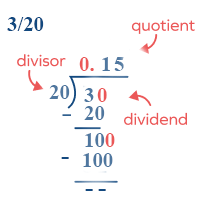
Explanation
Write 0. and add 0 to 3
Since 20 can't divide 3, write 0. at the quotient and add 0 to the dividend (3) to become 30
Divide 30 by 20
20 goes into 30, 1 time, and its written at the quotient
Multiply 1 by 20
The 1 at the quotient multiplies the divisor (20) and the result, 20 is written down
Subtract the 20 from 30
The 20 is subtracted from 30 and the 10 obtained is written down
Add 0 to the 10
Since 20, can't divide 10, 0 is added to the 10 to become 100
NOTE: Since we've already obtained our first divisible dividend, we don't have to add 0 to the quotient any time we add 0 to the dividend
Divide 100 by 20
20 goes into 100, 5 times and it is written at the quotient
Multiply the 5 by 20
5 at the quotient multiplies the divisor (20) and the 100 obtained is written down.
Subtract 100 from 100
The subtraction of 100 from 100 gives 0, hence the long division is completed.
Divide 2 by 500
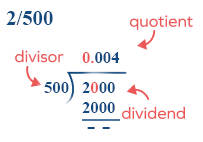
Explanation
Write 0. and add 0 to the 2
0. is written at the quotient and 0 is added to the 2 to become 20
500 cannot divide 20 yet so 0 is added after the decimal point and another 0 is added to the dividend (20) to become 200
500 cannot divide 200 yet so another 0 is added to the quotient and another 0 is added to the dividend (200) to become 2000
Divide 2000 by 500
500 divides 2000, 4 times, hence 4 is written at the quotient
Multiply 4 by the 500
The 4 is multiplied by the 500 to obtain 2000 and its written below
Subtract 2000 from 2000
The subtraction of 2000 from 2000 gives 0, hence the long division is completed.
APPLICATION OF KNOWLEDGE
Question 6
Find the missing addend:
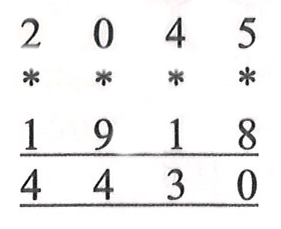
A. 8393 B. 1967 C. 2512 D. 467
[B.E.C.E 1990 Section A Question 18]
Question 7
Find the missing addend:
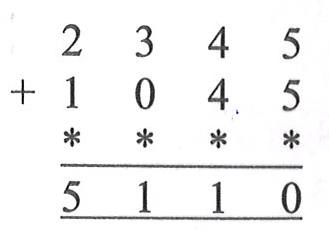
A. 1300 B. 1720 C. 2765 D. 4065
[B.E.C.E 1991 Section A Question 3]
Question 8
If X = {prime numbers less than 13} and
Y = {odd numbers less than 13}
(i) List the members of X and Y
[B.E.C.E 1991 Section B Question 1]
Question 9
The following addition is done in base ten. What number represents a b c?
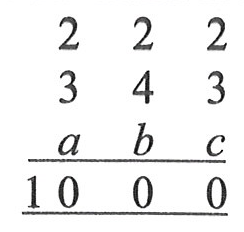
A. 324 B. 342 C. 423 D. 435
[B.E.C.E 1996 Section A Question 2]
Question 10
Which of the following is the set of factors of 12?
A. {12,6,4,3,2,1} B. {12,6,4,3,2}
C. {12,6,4,2} D. {6,4,2,1}
[B.E.C.E 1994 Section A Question 1]
Question 11
Find the set of prime factors of 12.
A. {3} B. {2,3}
C. {3,4} D. {2,6}
[B.E.C.E 1992 Section A Question 1]
Question 12
Find the missing numbers in the set
{5,10,15,...,25,...,...,40}.
A. 20 and 30. B. 30 and 35.
C. 20, 35 and 40. D. 20,30 and 35.
[B.E.C.E 2001 Section A Question 1]
Question 13
Find the sum of all the even numbers between 70 and 80.
A. 200 B. 223 C. 280 D. 300
[B.E.C.E 2001 Section A Question 7]
Question 14
M is a set consisting of all positive integers between 1 and 10. P and Q are subsets of M such that P = {factors of 6} and Q = {multiples of 2}
(i) List the elements of M, P and Q.
[B.E.C.E 2001 Section B Question 1 a]
Question 15
Find the product of 17 and 121.
A. 968 B. 1,751 C. 2057 D. 8,591
[B.E.C.E 2003 Section A Question 9]
Question 16
A and B are subsets of a universal set U = {1,2,3,4,5,6,7,8,9,10,11,12,13,14,15,16,17,18}
Such that A = {even numbers}
B = {multiples of 3}.
(i) List the elements of A,B
[B.E.C.E 2010 Section B Question 1 b]